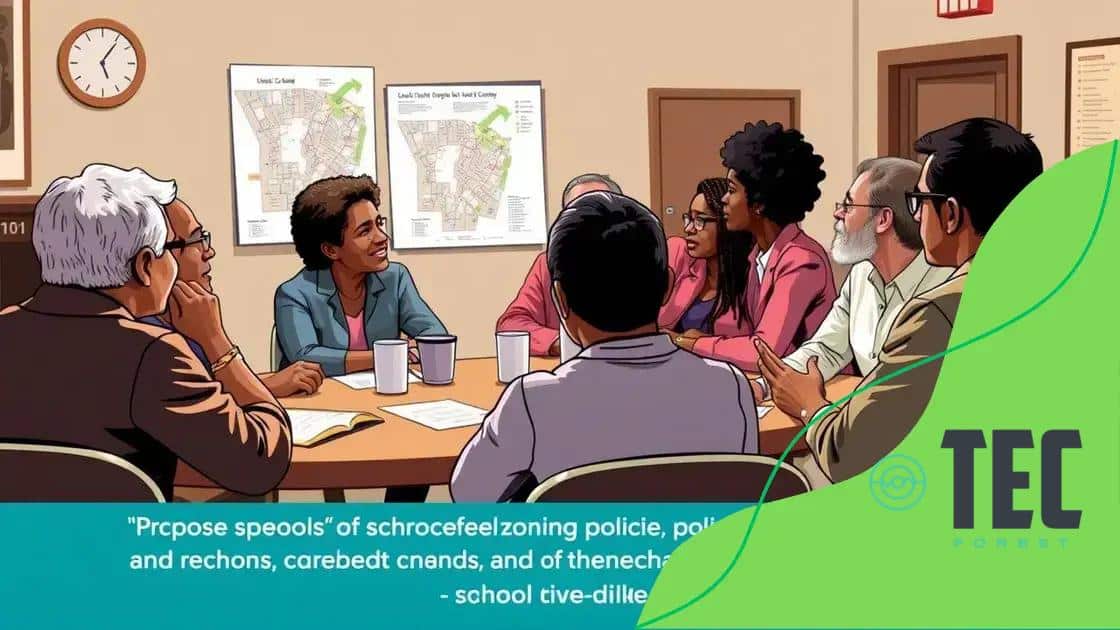Advertisement
School zoning policies under review for systemic bias highlight the need for equitable access to education, as biased practices often result in disparities in resources and opportunities for students in different neighborhoods.
School zoning policies under review for systemic bias have sparked important conversations about equity in education. Have you ever wondered how zoning can shape the future of students in different neighborhoods? This article explores the complexities involved.
Advertisement
Understanding school zoning policies
Understanding school zoning policies is essential for grasping how educational resources are distributed across communities. These policies can greatly affect students’ educational opportunities, influencing which schools they can attend based on their residential areas.
Often, zoning policies are designed to balance school populations and allocate funding efficiently. However, the methods used to determine these zones can sometimes lead to disparities in educational quality. For instance, neighborhoods with higher socioeconomic status tend to have better access to quality schools.
Advertisement
What are school zoning policies?
School zoning policies define the geographical boundaries for public school enrollment. They are crucial for managing school capacity and ensuring that students attend schools close to home. Understanding these policies helps identify potential biases that may occur.
- Zone definitions can vary significantly between districts.
- Changes in demographics often lead to zoning adjustments.
- Poverty levels can impact which schools are assigned to which zones.
- Community feedback is essential for creating equitable zoning policies.
Additionally, school zoning policies can reflect historical inequalities. For instance, areas that were once racially segregated may still see the effects of past zoning decisions, resulting in a legacy of unequal school resources. This becomes a critical conversation point as communities evaluate their current zoning practices.
Impact on education
The impact of zoning on education can be profound. Students living in underfunded zones may have fewer resources, such as advanced placement courses or extracurricular activities, than their peers in more affluent areas. When parents engage in discussions about school zoning, it is vital to highlight how zoning decisions can perpetuate educational inequities.
As public awareness grows, many communities are pushing for reforms to ensure more equitable access to quality education. This includes reviewing current zoning laws and considering community input to deviate from traditional zoning practices.
In summary, a clear understanding of school zoning policies is crucial for fostering fair educational opportunities. It enables stakeholders to advocate for changes that promote equity and inclusivity across all communities.
Historical context of zoning practices

The historical context of zoning practices offers critical insights into how current school zoning policies have evolved. Understanding this background is essential in recognizing the implications these policies have today.
Zoning practices in the United States date back to the early 1900s. Initially, zoning laws aimed to separate different land uses to promote safety and public health. Over time, these regulations also began to reflect and reinforce societal norms, often leading to the segregation of communities.
Early zoning laws
Early zoning legislation was influenced by industrialization and urban growth. As cities expanded, there became a pressing need to manage land use. Zoning laws were implemented with the intention of creating orderly and healthy environments for residents. However, these zoning decisions often correlated with race and income levels, which led to disparities in educational access.
- Zoning laws in the 1920s often segregated neighborhoods.
- Residential areas were designated based on economic status.
- Many zones excluded minority populations from certain areas.
- These early practices shaped the landscape of public education.
As the civil rights movement gained momentum in the 1960s, it became clear that many zoning practices were fundamentally unjust. Communities began to challenge these outdated laws. Legal battles ensued, and advocacy groups worked tirelessly for change. Despite this progress, the residual effects of historical zoning practices continue to influence educational inequality today.
Impact of historical practices
The impact of historical zoning practices on education is significant. Many public schools are funded through local property taxes, which often results in disparities based on the socioeconomic status of the community. Areas that were historically marginalized still struggle with underfunded schools, perpetuating a cycle of disadvantage.
In recent years, there has been a push for zoning reform to address these long-standing inequalities. Communities are advocating for transparent processes to ensure that zoning decisions reflect the needs of all residents. By understanding the historical context of zoning practices, it’s clear that meaningful change is necessary to create a more equitable education system for future generations.
Impacts of biased zoning on communities
The impacts of biased zoning on communities are evident in many aspects of daily life. These impacts shape not only educational opportunities but also the overall health and well-being of residents.
Biased zoning can lead to significant disparities in resources. When certain neighborhoods are designated for specific schools, it often correlates to the socioeconomic status of that area. Schools in affluent zones typically receive more funding and have better facilities compared to those in less wealthy neighborhoods.
Consequences for education
Access to quality education is one of the most critical impacts. Students in underfunded school zones may not have access to advanced placement courses or extracurricular activities. This can affect their future opportunities, including college admissions and job prospects.
- Underfunded schools struggle to attract qualified teachers.
- Students may have fewer resources, such as textbooks and technology.
- Class sizes can be larger, impacting individual attention.
- Graduation rates often suffer in areas with biased zoning.
Moreover, biased zoning can also affect community cohesion. When schools are divided by socioeconomic status, they often become breeding grounds for tension. This division can limit the interactions between students from different backgrounds, reinforcing stereotypes and social barriers.
Economic implications
Economically, communities facing biased zoning may experience stagnation. When students do not receive quality education, it impacts the local workforce in the long term. A poorly educated population can lead to higher unemployment rates and reduced economic growth.
Addressing these zoning issues requires input and action from the community. Advocacy for fair zoning practices can help bring attention to the disparities and promote change. Community workshops and discussions are critical in creating awareness about the negative impacts of biased zoning.
In essence, understanding the impacts of biased zoning helps highlight the need for reforms that can lead to equitable access to educational resources for every student, no matter where they live.
Analyzing proposed changes to zoning policies

Analyzing proposed changes to zoning policies is critical as communities seek more equitable solutions in education. Recent discussions have highlighted the need to reassess how these policies affect students from different backgrounds.
Several changes are being considered to address longstanding inequities. For example, some districts are exploring diverse zoning models that allow for more mixed-income neighborhoods. This could help ensure that all students have access to better resources and facilities, regardless of their homes’ locations.
Proposed reforms
One proposed reform involves the implementation of inclusive zoning practices. This approach aims to create school zones that reflect the demographics of the entire community rather than just one area. By integrating multiple neighborhoods into school zones, it could promote a more diverse student body, fostering an environment that values inclusivity and equal opportunities.
- Addressing funding disparities between schools.
- Encouraging family input in zoning decisions.
- Enhancing transportation options for students in different zones.
- Implementing policies that prioritize educational equity.
Furthermore, there is a focus on community engagement. Public forums and discussions allow parents and local residents to voice their opinions about proposed changes. This engagement is crucial, as it ensures that the voices of those most affected by zoning policies are heard and considered in the decision-making process.
Potential benefits
Analyzing these changes helps to identify potential benefits for students and communities alike. With more equitable zoning policies, families in underserved communities could gain access to better educational opportunities. This shift can lead to higher graduation rates and improved college readiness.
Moreover, schools can better utilize resources when they draw from a more diverse population. A richer mix of students often leads to enhanced learning experiences, encouraging innovative ideas and collaborative projects.
In conclusion, exploring the proposed changes to zoning policies offers valuable insights into creating a fairer education system. Ensuring that all students have equal access to education is essential for building a brighter, more equitable future.
Community responses to zoning reviews
Community responses to zoning reviews are essential to understanding the implications of school zoning policies. As local governments review these policies, community members often come together to voice their opinions and advocate for change.
During zoning reviews, residents express a range of perspectives, from concerns about educational equity to suggestions for improvement. This grassroots involvement provides invaluable insights into how zoning practices affect different neighborhoods.
Common concerns
Many community members share concerns regarding the impact of biased zoning on school resources. They note that students in underfunded zones may face challenges that hinder their educational success. This conversation is crucial for unearthing the disparities that often remain hidden.
- Access to quality education is a primary concern.
- Residents worry about the long-term effects on property values.
- Communities emphasize the need for greater transparency in zoning decisions.
- Parents often seek assurance of equitable treatment for all students.
In addition, community responses can shape the narrative around zoning policies. Local advocacy groups often mobilize to pressure lawmakers to reconsider outdated zoning laws. This activism is vital in raising awareness and fostering dialogue about the need for reform.
Positive initiatives
Some neighborhoods have successfully implemented initiatives to improve the zoning review process. For instance, community workshops allow residents to collaborate and share ideas for more equitable zoning practices. These events empower residents and enable them to participate meaningfully in decision-making.
Engagement efforts, such as surveys and town hall meetings, also enhance communication between residents and school officials. By creating platforms for discussion, communities can ensure that their voices are heard and considered in the zoning review process.
Ultimately, community responses to zoning reviews play a pivotal role in shaping the future of education in their areas. Advocacy from residents can lead to more equitable policies and a better educational landscape for all students.
FAQ – Frequently Asked Questions About School Zoning Policies
What are school zoning policies?
School zoning policies determine which schools students can attend based on their residential address, impacting educational equity.
How do biased zoning practices affect education?
Biased zoning can lead to disparities in school funding and resources, affecting the quality of education available to students.
Why is community engagement important in zoning reviews?
Community engagement ensures that residents’ voices are heard, helping to identify issues and advocate for fairer zoning practices.
What are some proposed changes to zoning policies?
Proposed changes include inclusive zoning practices that consider diverse neighborhoods, aiming to promote equal access to quality education.
